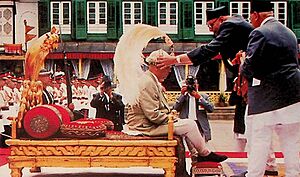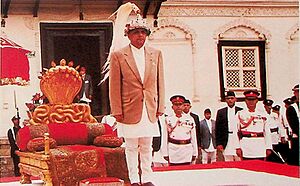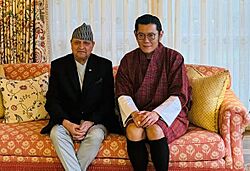Gyanendra of Nepal facts for kids
Quick facts for kids Gyanendra Shah
|
|||||
|---|---|---|---|---|---|
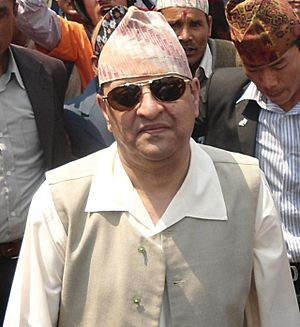
Gyanendra Shah in 2012
|
|||||
| King of Nepal | |||||
| Reign | 7 November 1950 – 7 January 1951 | ||||
| Coronation | 7 November 1950 | ||||
| Predecessor | Tribhuvan | ||||
| Successor | Tribhuvan | ||||
| Prime Ministers |
See list
Mohan Shumsher Jang Bahadur Rana
|
||||
| Reign | 4 June 2001 – 28 May 2008 | ||||
| Coronation | 4 June 2001 | ||||
| Predecessor | Dipendra | ||||
| Successor | Monarchy abolished (Girija Prasad Koirala as the acting head of state) |
||||
| Prime Ministers |
See list
|
||||
| Born | 7 July 1947 Narayanhiti Royal Palace, Kathmandu, Nepal |
||||
| Spouse |
Komal Shah
(m. 1970) |
||||
| Issue | Paras Shah Prerana Shah Singh |
||||
|
|||||
| House | Shah Dynasty | ||||
| Father | Mahendra | ||||
| Mother | Indra Rajya Lakshmi Devi | ||||
| Religion | Hinduism | ||||
Gyanendra Shah (born 7 July 1947) was the last monarch of Nepal. He ruled from 2001 until 2008, when the monarchy was ended. He had also been king for a short time as a child, between 1950 and 1951. This happened when his grandfather, King Tribhuvan, and his family went to India for political reasons.
His second time as king began after a tragic event in 2001 involving the royal family. His rule was marked by big changes in Nepal's government. His brother, King Birendra, had set up a constitutional monarchy. This meant the king shared power with an elected government. During Gyanendra's reign, a conflict called the Nepalese Civil War grew. This made it hard to hold elections.
In February 2005, after many election delays, Gyanendra took direct control of the country. He said this was a temporary step to stop the Maoist rebels, as the elected governments had failed. However, in April 2006, he brought back Nepal's parliament after many protests. Two years later, in 2008, the Constituent Assembly removed him from power. They declared Nepal a Federal Democratic Republic, ending the 240-year-old Shah dynasty.
Contents
Early Life and First Time as King
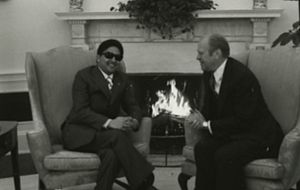
Gyanendra was born on 7 July 1947, in the old Narayanhiti Royal Palace in Kathmandu. He was the second son of Crown Prince Mahendra and his first wife, Crown Princess Indra. After he was born, a court astrologer told his father not to look at him, saying it would bring bad luck. So, Gyanendra was sent to live with his grandmother.
In November 1950, during a political problem, his father and grandfather, King Tribhuvan, along with other royals, left for India. This left young Prince Gyanendra as the only male royal in Nepal. The Prime Minister, Mohan Shamsher, brought him back to Kathmandu. On 7 November 1950, Gyanendra was declared king. Coins were even made with his name on them. The Prime Minister's family, the Ranas, gave the king a large annual budget.
However, India did not support the Rana prime ministers' rule. A deal was made in January 1951. Gyanendra's grandfather, King Tribhuvan, returned to Nepal and became king again. Other countries did not recognize the Rana government's actions to make Gyanendra king.
Gyanendra studied with his older brother, King Birendra, at St. Joseph's School, Darjeeling, in India. In 1969, he finished his studies at Tribhuvan University in Kathmandu. He was also involved in protecting nature. From 1982 until he became king again in 2001, he led the King Mahendra Trust for Nature Conservation.
Gyanendra married his cousin, Komal Rajya Lakhsmi Devi, on 1 May 1970. They have two children:
- Prince Paras Bir Bikram Shah Dev (born 30 December 1971)
- Princess Prerana Rajya Lakshmi Devi Singh (born 20 February 1978)
Becoming King Again
Gyanendra became king again after a very sad event on 1 June 2001. Many members of the royal family, including King Birendra, passed away. His nephew, Crown Prince Dipendra, was briefly king before he also passed away. These events were very difficult and led to much discussion.
A team was set up to investigate what happened. After talking to many people, they concluded that Dipendra was involved in the tragedy. While his nephew was unwell, Prince Gyanendra was made regent, meaning he ruled in place of the king. After King Dipendra's passing on 4 June 2001, Gyanendra became the new king.
Second Time as King
Early Years of His Rule
When Gyanendra first became king, he wanted to have strong control over the government. He felt that political parties had failed to hold elections after the parliament was dissolved. In May 2002, he supported Prime Minister Sher Bahadur Deuba when he dismissed the parliament. In October 2002, Gyanendra dismissed Deuba and took more power for himself.
Between 2002 and 2005, he chose and then dismissed three prime ministers. He said they failed to hold elections and make peace with the Maoist rebels. Finally, he dismissed Deuba for a second time and took complete control on 1 February 2005. He promised that Nepal would return to normal within three years.
His older brother, King Birendra, had managed a constitutional monarchy carefully. He played a smaller role in the government. Because of this, Gyanendra's way of dealing with political parties was not popular.
When Gyanendra took full control in February 2005, he removed Prime Minister Sher Bahadur Deuba's government. He said it was because they could not arrange elections or bring peace during the Nepalese Civil War. Gyanendra promised to bring "peace and effective democracy" within three years. However, his direct rule also meant that people's freedoms were limited. International groups worried about the safety of journalists and the lack of freedom of the press.
In April 2006, several political parties and the Maoist party held protests and strikes in Kathmandu. They were against King Gyanendra's direct rule. The government tried to control the situation with curfews, tear gas, and sometimes live firearms. After 23 protesters passed away, King Gyanendra announced on 21 April 2006 that he would give power back to a new prime minister chosen by the political parties. This was to bring democracy back.
Some party leaders did not accept this offer. They demanded that the King call a meeting to decide the future of the monarchy. An agreement was reached between the parties, with India's help, that the monarchy would still have a place in the new constitution. Girija Prasad Koirala was made interim prime minister. On 24 April 2006, Gyanendra brought back the previous parliament in a speech on TV.
End of Direct Rule
The agreement between the parties and Gyanendra was not fully followed by the parties. Many believed that Prime Minister Girija Prasad Koirala thought that as long as Gyanendra had power, democracy in Nepal would be at risk. On 10 June 2006, the Parliament removed many of the king's powers, including his right to stop laws. This meant the king became a symbolic leader, with no real power. All the powers of the 239-year-old monarchy were taken away, making Gyanendra a civilian king.
Prime Minister Koirala, who had supported the monarchy before, said in March 2007 that Gyanendra should step down. In June, Koirala again asked Gyanendra to give up his title in favor of his grandson, Prince Hridayendra.
On 23 August 2007, Nepal's government took control of all the properties Gyanendra had inherited from his brother, including the Narayanhiti Royal Palace. This did not affect properties he owned before he became king.
Monarchy Ends
On 24 December 2007, it was announced that the monarchy would likely be ended in 2008. This was part of a peace deal with the Maoist rebels. A bill was passed to change the constitution and make Nepal a republic.
On 28 May 2008, the monarchy was officially removed from the constitution and replaced by a republic. This was decided by the Constituent Assembly. Gyanendra accepted this decision in the days that followed. He was asked to leave Narayanhiti. On 4 June, the government decided to give Nagarjuna Palace to Gyanendra as his new home.
Gyanendra left the Narayanhiti Palace in Kathmandu on 11 June 2008 and moved to Nagarjuna Palace. His new home has ten buildings, including his residence and guesthouses. Gyanendra and his family moved into the two-story Hemanta Bas. After he left, the Narayanhiti Palace became a museum. Gyanendra's crown, royal scepter, and other royal jewels became government property. The royal family leaving the palace was a big moment, marking the end of the Shah dynasty, which had united Nepal in the 1760s.
Gyanendra spoke to foreign reporters on 9 April 2008. He said he was not happy with the decision to end the monarchy. He felt it did not show what most people wanted. However, he agreed that people had the right to choose the future of the monarchy.
He also said that law and order in Nepal were getting worse. He questioned if the government could rule the country, even after he had accepted their plans. He mentioned a survey that showed many people still wanted the monarchy in some way.
In 2020, the RPP-N collected 2.35 million signatures. They asked for a public vote on the future of the 240-year-old monarchy and for Nepal to be a Hindu state.
Recent Events
In October 2024, Gyanendra visited Bhutan after being invited by the Bhutanese royal family. He was welcomed warmly at the airport. Gyanendra, along with his daughter Princess Prerana Shah and niece Princess Sitashma Shah, met with the former King of Bhutan, Jigme Singye Wangchuck, and the current King, Jigme Khesar Namgyel Wangchuck, and his family.
In February 2025, Gyanendra shared a video message. He said he was worried about democracy in Nepal and asked people to support him for unity and peace. He received a lot of public support during his travels, with crowds chanting for him to return. A large rally was held in Kathmandu in March 2025, with many people supporting the monarchy.
Wealth
Even though the government took control of the properties he inherited from his brother, King Birendra, Gyanendra still kept all the wealth he had before he became king. He was a businessman connected to the state and inherited a lot of money from his family. He still runs many successful businesses through investments. It is believed he is worth hundreds of millions of dollars.
In 2008, a journalist said that King Gyanendra had investments in at least 35 companies in Nepal and possibly more abroad. His investment in Soaltee Hotel alone was thought to be around $100 million in 2008, with him owning 47% of it.
He also reportedly owned 54% of Himalayan Goodricke Tea and 39% of Surya Nepal Tobacco. He had shares in Annapurna Hotel, which he inherited from his aunt, Princess Helen. He also owned large tea farms in Itahari and had investments in other companies like Himal International Power Corporation, Jyoti spinning mill, Narayanghat brewery, and car dealerships for Toyota and Tata. He also had interests in an island in the Maldives and oil in Nigeria.
Additionally, the former king owns large areas of land across Nepal. He has many properties, including Nirmal Niwas palace, his personal home of about 36 ropani (a unit of land measurement) in a good location in Maharajgunj. He is also said to have very valuable items from the Shah and Rana dynasties, including precious jewels and artwork.
Honours
National Awards
 Sovereign of the Order of Nepal Pratap Bhaskara
Sovereign of the Order of Nepal Pratap Bhaskara Sovereign of the Order of Ojaswi Rajanya
Sovereign of the Order of Ojaswi RajanyaSovereign of the Order of Nepal Taradisha
 Sovereign of the Order of Tri Shakti Patta
Sovereign of the Order of Tri Shakti Patta Sovereign of the Order of Gorkha Dakshina Bahu
Sovereign of the Order of Gorkha Dakshina Bahu- Most Glorious Mahendra Chain
- Birendra Chain (29 December 2002)
 King Mahendra Investiture Medal (2 May 1956)
King Mahendra Investiture Medal (2 May 1956) King Birendra Investiture Medal (24 February 1975)
King Birendra Investiture Medal (24 February 1975) Commemorative Silver Jubilee Medal of King Birendra (31 January 1997)
Commemorative Silver Jubilee Medal of King Birendra (31 January 1997)
Awards from Other Countries
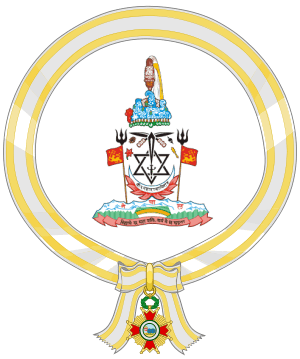
 Bhutan:
Bhutan:
 France:
France:
 Grand Cross of the National Order of Merit, 2 May 1983
Grand Cross of the National Order of Merit, 2 May 1983
 Germany:
Germany:
 Grand Cross of the Order of Merit of the Federal Republic of Germany, 25 November 1996
Grand Cross of the Order of Merit of the Federal Republic of Germany, 25 November 1996
 North Korea:
North Korea:
 South Korea:
South Korea:
 Netherlands:
Netherlands:
 Pakistan:
Pakistan:
 Saudi Arabia:
Saudi Arabia:
 Spain:
Spain:
 Knight Grand Cross of the Order of Isabella the Catholic, 13 November 1987
Knight Grand Cross of the Order of Isabella the Catholic, 13 November 1987
 Thailand:
Thailand:
 United Kingdom:
United Kingdom:
 Honorary Knight Grand Cross of the Order of St. Michael and St. George, 1986
Honorary Knight Grand Cross of the Order of St. Michael and St. George, 1986
 Yugoslavia:
Yugoslavia:
Images for kids
See also
 In Spanish: Gyanendra de Nepal para niños
In Spanish: Gyanendra de Nepal para niños


